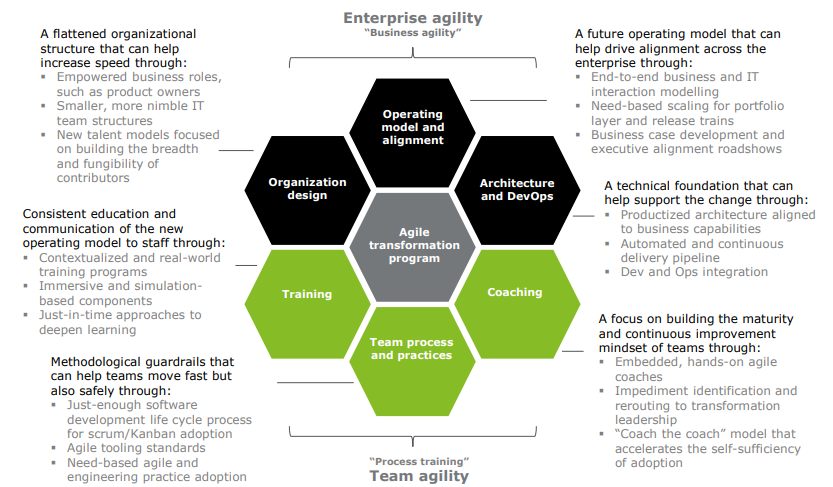When we learn something new, we learn everything that has already happened in its past. All the stories, the techniques and overall knowledge that one acquires during the learning phase is already there, right in front of him. Like playing the guitar, the strings and the cords are right there for you to master. You can listen to old recordings and songs and practice them and given you are dedicated, you’ll be able to learn this art.
The key here is consistency, the art has been developed and tried by many and it’s not going to change. The strings on the guitar will remain the same. But what happens when you are trying to master something that is not consistent, something that keeps evolving, something that is so dynamic that predicting it would be a massive task with no reliable answers. What happens then?
That something is the business world and its constantly changing markets. How do businesses operating in this dynamic world become able to catch up to its never ending changes? They must have a way, otherwise turning a profit of any means would be next to impossible.
What do you think would be the right strategy to master something that is dynamic and ever-changing? The only option that I could think of was to become as dynamic as that. When businesses become nimble, agile and quick-thinkers, they’ll be very conveniently able to overcome any change the markets throw at them. And if I had to give a name to this process, Agile Transformation would be it.
So, that’s what we are going to be discussing today. Agile transformation and everything that it entails, from agile transformation frameworks to the benefits it provides. Let’s delve into it.
Understanding the Concept of Agile Transformation
If I had to choose four adjectives for illustrating the concept of agile transformation, I’d be using words like;
Flexible;
Reactive;
Collaborative;
And self-organising; if that is indeed an adjective.
It’s these four words that sum up the entirety of this concept of organisational structure, you could even call them its essence.
Agile transformation happens when an organisation starts transforming itself to a paradigm that embraces the four adjectives I mentioned earlier. Being flexible, reactive, collaborative and self-organising in every dimension of the business, be it product development or its marketing, is what agile transformation is all about.
The term agile in the concept is its heart and soul. And it does not mean aligning an organisation with the agile software development methods, agile transformation is much bigger than that.
The agile manifesto will help you understand the concept and all of its principles that act as its guiding force.

If we look at the first principle, it states the prioritisation of consumer satisfaction, which is essentially done through early and continuous delivery of software that is valuable to them. The eleven other principles are equally important for an organisation’s total and complete transition to being agile.
What’s imperative for an agile transformation is the change in the mindset of everyone involved in the process because only then will you be able to reap any benefits. Starting by renewing your focus on customer satisfaction, reducing the never-ending plans and processes and increasing the action behind them is a great way for achieving that. More about the agile development methodology here.
Why would you need to be agile in a dynamic business environment?
So, you know what agile transformation is and you even know the principles that would help you in understanding the depths of the concept. However, you still must be wondering why? Why go for agile transformation, when your current system is working just fine?
What would you say if I told you that with the agile transition, you’d be able to focus on delivering value to your customers because your team would be divided into smaller teams, working in short cycles that would not be shadowed by the top-down bureaucracy and silos of the previous century. Does this seem like a compelling enough reason to be agile?
Will Steve Denning convince you?
“Agile organizations are connecting everyone and everything, everywhere, all the time. They are capable of delivering instant, intimate, frictionless value on a large scale…”
Well, at the end of the day, it is going to be your call, but I would say that the benefits that the agile transition brings along are reason enough for your call to become inclined to the agile way.
It’s a transition where customers are prioritised
The foremost benefit of the agile approach is that it prioritises the consumer over anything else. It's obvious from the very first principle of the agile manifesto. Development that is centred around the consumer with his point of view and vision decides the core is the kind of development that is meant to bring you acclaim and profits alike.
It’s a transition where employees are heard, valued and happy
Gone are the days when employees were practically slaves. Today, innovation, passion, intuitiveness, commitment and motivation are things organisations have to capitalise from their employees, if they wish to succeed and the agile way helps immensely in that.
The entire workforce sticks together, there are shared goals, a united environment with individual responsibility and accountability, all of which results in better outcomes for everyone. To know more, read about the importance of team health and productivity for a business, diversity and inclusion at the workplace, and human psychology in project management.
It’s a transition where efficiency is higher
The agile transformation is extremely efficient and it is because of the fact that this approach focuses on collaboration and interaction between teams. What this means is that a department would not become isolated, it would be involved in the workings of their colleagues as well. As a result teams can share their expertise and skills they have acquired with each other, which can only mean one thing and that is better products created in an efficient manner.
It’s a transition where you can change the plan with ease
The term agile itself means to be flexible and able to adapt to anything. So, the agile transformation allows organisations to cater to the ever changing priorities with ease. A plan for the development of the software may seem too good today, but five months down the production cycle, the original plan could seem a little outdated.
The only solution here is to become able to respond to the changes in consumer demands even during the development phase. Because agile transformation embraces that, organisations become equipped to handle the changing priorities. Consequently, you develop a kind of market resilience that would keep you up to speed with its changes.
All in all, the agile way is a transition where business success is almost inevitable and that should be reason enough to take it up.
What is the Ideal Agile Transformation Strategy?
We have established the what and the why of the agile transformation, now it's time to bring in the how by talking about the ideal agile transformation strategy which will make all those benefits we just discussed seem quite tangible.

Deloitte has very articulately described the agile transformation program. It has covered every aspect of the transition to get the best possible restructuring of the organisation. From the overall organisational design and architecture to the team and its training to the future operating model, everything needs to be considered and given its due diligence during the transitional phase.
Let’s try to understand the strategy for agile transformation a little bit more. I felt that the strategy is basically an agile transformation roadmap that has four main stages.
The Pre-requisite: Current Analysis of Where Everything Stands
The first thing to do when taking on an agile transformation is to know where you stand, to know where to start and to know whether you are even ready.
The agile transformation framework is quite intensive to implement, you’d be essentially changing the whole outlook of your organisation’s operations in every level, this mandates you know the risks and benefits of the implementation. Being a two decade old framework, there is a lot of groundwork you’d have to cover. You should also take into account that the process isn’t going to happen overnight, Microsoft began its agile journey in 2008 and they have completely transformed even today. Is your organisation ready for that long a period of transformation at that massive a scale?
There is another thing that is extremely important to analyse and that is what you expect out of the transformation, you are going to have some very specific needs out of it. Your organisation has to have a certain level of agility in roles, workflows, products and even how you deal with the market and consumers. So, why do you need to be more agile? What are you aiming to gain? Identify that first.
You need to ask yourself the right questions.
- Do you wish to enhance product performance by integrating a system that has room for feedback and values it?
- Are you unable to keep pace with the constantly evolving technology and the speed at which consumer demands vary?
- What kind of technology do you plan to harness that’ll allow you to get to your goals?
- Which areas do you plan to target initially to get faster results and kickstart the transformation with a better momentum?
- Do you plan to change the management process entirely to facilitate better communication?
- Are you planning to achieve all your agile goals within stipulated deadlines?
- Do you have a plan to maintain profitability while that transformation would be ongoing?
Since every agile transformation is different, this analysis becomes the key to make your agile transformation go a little smoother. With targets set and current stock taken into account, you will have your final vision within your sights.
The Understanding: Of Technology, Of Leadership and Of Connections
From the analysis the agile strategy moves on to the understanding stage of the process. This involves three parts.
Technology
Technology needs to be in sync with the business capabilities. What this means is that the technological environment of the organisation should be decided by how it is consumed by its products and its capabilities. These include every dimension of the business, from customer journey to the business process and its value streams, all of which have to be aligned with the technology available. You can consider your counterparts as a source for the alignment and even technology leaders, if possible.
This is crucial for the agile transformation because a sync in the business and technology or its owners, if they are separate from the business, would keep the agile teams in sync which would in turn keep the focus on the achievement of business goals.
Leadership
Moving on from technology, the support of the leadership is crucial too for the transformation. An agile transformation framework would affect every aspect of the business, so the leadership has to be on board. Although managers and agile champions are enough to get the process started, the holistic transformation is a C-suite job.
The leadership is also responsible for forming, training and coaching teams to move forward with the transformation. C-suite’s role is to also formulate metrics to realise the vision that was decided in the very beginning and communicate the same to the teams.
Connections
There is going to be a plan of action from the time the transformation would begin, and there will be chances that the decided plan would need to be altered. The hypothesis, the experiments and the consequent outcomes may have to be ignored for something else.
These situations will arise and you have to be able to form connections here before proceeding with the changes. There is no way to know what will work in the future, but there will always be a way to connect whatever change has been made to the desired business outcomes, which will be connected to the business objectives that are the reason for the agile way. These connections are crucial to be identified to avoid the process from going astray.
The Appraisal: Finding The Value of Agility
The agile transformation practices are going to last for a long time and you can’t wait that long to check whether everything is going on track. Ideally a 90-day plan is perfect, it decides all that which needs to be accomplished in the said 90-days. Once they are up, the progress is evaluated and the setbacks are corrected.
Yes, setbacks are going to be there and that is inevitable and you have to accept that. Even a tech giant like Microsoft wasn’t able to complete one agile sprint for as long as a year into the transformation. However, when you keep checking the progress, you can be one step ahead of the setbacks and work on the necessary adjustments.
Furthermore, you need to become accustomed to working on smaller teams, implementing the agile management successfully, then move on to the next small team. As successes would continue, the word would spread, people would start getting inspired more and more. This also helps in preventing resistance, which is highly likely when such a foundation change is on the horizon. And that is how you’ll be able to value agility.
The Sustainability: Retaining The Accomplished Hard Work
You’ve done the hard work, now it’s time to retain it. Up until now, the plans will get implemented and the results will become evident. So, what will you do? You’ll establish the practices that work best for you, document them and make them the strategy moving forward.
You could even base your training and development methods based on those successful practices and those will help you retain every bit of success you have accomplished.
There is one more thing, you cannot let agile become a mere source for cost reduction. You cannot allow it to be something only relevant for the top management, while the others follow a 180 degree contracting management of workflows. Something like that would never make agile transformation sustainable.
Comprehending the Agile Obstacles
The agile transformation isn’t one that would be without any hiccups in the journey. Given the fact that this is one journey that can last even a decade makes it certain that there are going to be challenges. Let’s shine some light on them.
The lack of clarity
The foremost obstacle is the one where the strategy begins and that is the end vision, the purpose of transforming. If the vision isn’t inspiring enough, if it doesn’t seem feasible enough, if the stakeholders don’t believe in it, the agile way is doomed from the get go. You have to inspire people to move forward through the ultimate goal, instead of making them doubt it.
Why are you transforming? Remind yourself, remind others – often. The vision of the transformation is not the same as your business’ mission, though they are necessarily intertwined. Your survival is at stake; your transformation vision needs to inspire people to keep moving forward.
The leadership changes
This is probably the most common hiccup in the agile way. I have said, quite a few times, that the transition is a long and lengthy process. Through its implementation, there are often changes in the leadership. These changes can mean that the new appointees think differently of the transformation and can put a stall on it or take it in an entirely new direction. This sometimes results in the transition ending before it was even completed because the new management believes in the traditional way of working.
The stakeholders’ mismatch
The number of employees in a company is equal to the number of stakeholders in the agile transformation and that is the number of transitions that need to be done in the process. With that many stakeholders, there are going to be more disputes in rangers to motives, aspirations and fears. They need to be in sync with each other or else the transition goes in the wrong direction. The challenge is to turn down the work that will make that a possibility.
The communication problem
This one is basically an extension of the last obstacle. Much like any new concept and its consequent resistance in adoption, the agile way is no different. So, communicating its value to each employee can become a challenge. What is even more challenging is making them understand that value beyond their department. The perception of the accounting department and that of marketing would be very different for consumer service, right?
Conclusion
Now you know it all, everything there is to know about the agile way of business operations. In this way, operating environments, strategic responsiveness and organisational flexibility are given importance. All three have equipped organisations to handle the dynamic business environment.
When you consider going agile, the goal is often to make an organisation gain the capability to outperform its competitors. This ability is the result of driving growth even in ambiguous circumstances through constant learning and adapting. With an agile transformation, organisations are able to confront unforeseen situations without cowering.
Subscribe
Related Blogs
Trek n Tech Annual Retreat 2025: A 7-Day Workcation of OSL

OSL family came together for the Trek n Tech Annual Retreat 2025, a 7-day workcation set amidst the serene beauty of…
Exploring Drupal's Single Directory Components: A Game-Changer for Developers

Web development thrives on efficiency and organisation, and Drupal, our favourite CMS, is here to amp that up with its…
7 Quick Steps to Create API Documentation Using Postman

If you work with API , you are likely already familiar with Postman, the beloved REST Client trusted by countless…




